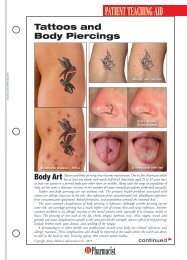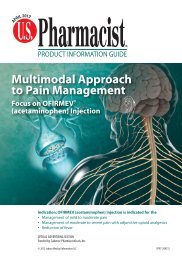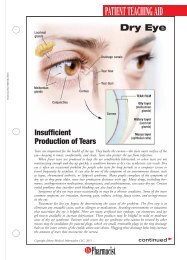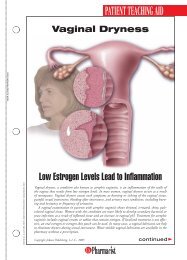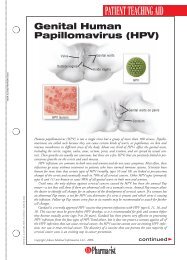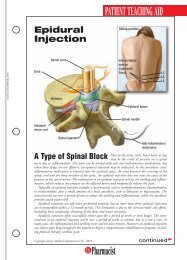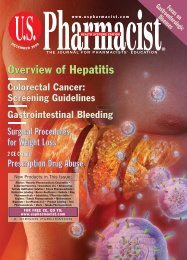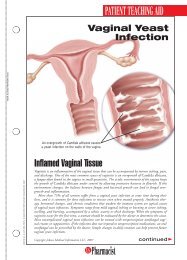View PDF Edition - U.S. Pharmacist
View PDF Edition - U.S. Pharmacist
View PDF Edition - U.S. Pharmacist
Create successful ePaper yourself
Turn your PDF publications into a flip-book with our unique Google optimized e-Paper software.
HEALTH SYSTEMS EDITIONNewly Approved mTORInhibitors for the Treatment ofMetastatic Renal Cell Carcinoma© JUPITERIMAGESThe American Cancer Society has estimated that57,760 new cases of kidney cancer and 12,980deaths due to kidney cancer will occur in theUnited States in 2009. Included in these statistics arerenal cell carcinoma (RCC) and transitional cell carcinomaof the renal pelvis. Kidney cancer is one of the 10 mostcommon types of cancer in men and women, with menat higher risk than women. The overall lifetime risk ofdeveloping kidney cancer is approximately 1 in 75 (1.34%). 1RCC constitutes 90% of kidney cancers, and the peakincidence is in the sixth decade of life. The histology isprimarily clear cell carcinoma (85%); the remaining 15%comprises papillary, chromophobe, and collecting-ductcarcinomas. The incidence of RCC is increasing, andabout 30% of patients present with metastatic disease.Risk factors include smoking, hypertension, obesity,cystic kidney disease, and genetic abnormalities. Onegenetic abnormality is the mutation of the von Hippel-Lindau tumor-suppressor gene often seen in clear-cellcarcinomas. 2Patients with metastatic RCC have an estimated 10%survival rate at 5 years. A prognostic model to predictsurvival was developed to stratify patients into low-risk(no risk factors), intermediate-risk (1-2 risk factors), andpoor-risk categories (>2 risk factors). 2 See TABLE 1 forpredictors of short survival. 3Current Treatment OptionsSurgery is an important option forpatients with RCC. Localized diseasecan be cured with surgery; unfortunately,Diana Hey Cauley, PharmD, BCOPClinical Pharmacy Specialist,Genitourinary Medical OncologyDivision of Pharmacy, University of TexasM.D. Anderson Cancer CenterHouston, Texasabout 30% of these patients will have disease recurrence.Surgery is a good choice for patients with advanceddisease, benefiting quality of life by reducing pain orbleeding, and sometimes even improving survival. 4For many years, immunotherapy with the biologicresponse modifiers interleukin-2 (IL-2) and interferonalpha(IFN-A) has been the mainstay of systemic treatmentfor metastatic disease. Treatment with these agentsalone or in combination yields a median survival of 12to 17.5 months. 3 High-dose IL-2, which was FDAapprovedin 1992 for advanced RCC, provides durablecomplete response in a small fraction of patients. Conventionalchemotherapy yields response rates of less than10% and often is used in a palliative context. High-dosenonmyeloablative chemotherapy followed by allogeneicstem-cell transplantation remains experimental. 2,4Targeted therapies have been developed to interferewith intracellular signaling, tumor-cell proliferation,differentiation, and angiogenesis. The small-moleculetyrosine kinase (TK) inhibitors bind to receptor TKs(RTKs) located on cell-surface growth factor receptors(GFRs), thereby inhibiting tumor growth. 2 Sorafenib,which was approved in 2005 for advanced RCC, inhibitsmultiple intracellular and cell-surface kinases, includingRaf; vascular endothelial GFR types 1 to 3 (VEGFR1-3); platelet-derived GFR (PDGFR)-beta; the stem cell factor receptor (c-kit);Fms-like TK-3 (Flt3); and glial cellline–derived neurotrophic factor receptor(RET). 4,5 Sunitinib, approved foradvanced RCC in 2006, also inhibitsHS-20U.S. <strong>Pharmacist</strong> • November 2009 • www.uspharmacist.com




